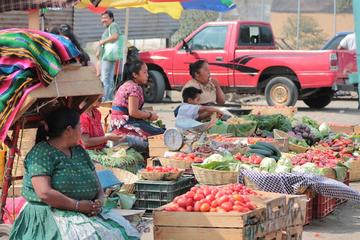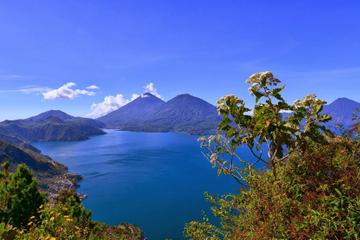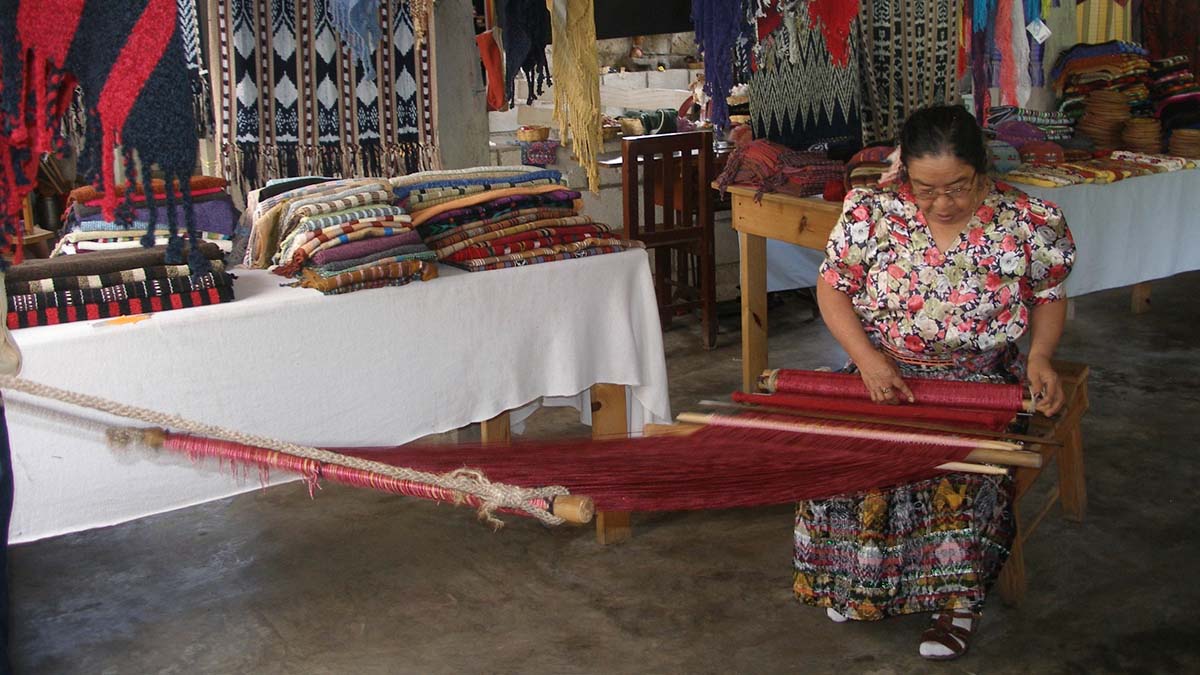
by Troy Herrick
Lake Atitlán, nestled within the fog-shrouded mountains of the Guatemalan highlands, is graced with twelve towns scattered around its periphery like the pearls of a necklace. Over 90% of the inhabitants in the area are indigenous people but you will not find any Mayan ruins here because these towns were all established during the Post-Classical Period. You can develop a flavour for the area by taking a boat ride to the three towns of Santiago de Atitlán, San Juan La Laguna and San Pedro La Laguna by way of Panajachel, your gateway to the lake.
As we crossed Lake Atitlán by speedboat towards the town of Santiago de Atitlán, Alex, our guide, quietly informed us that this lake was once a volcanic caldera, formed some 84,000 years ago. The caldera imploded on itself and was subsequently drained of its magma. The present day lake is set against a backdrop of three volcanoes named San Pedro, Tolimán and Atitlán on its southern shore. With a little imagination we could almost see images of these volcanoes reflected on the mildly choppy water. Since the winds become notoriously strong on the lake in the afternoon, this was likely to be the best image we would see of the three cones on the water. What Alex didn’t say was whether or not these volcanoes were still active.
Arriving at Santiago de Atitlán, a former Mayan capital, we swapped the speedboat for a tuk-tuk and raced through the narrow streets to our first stop – the local shaman who is the people’s intermediary with the local Mayan gods through a statue of Rilaj Mam known as the grandfather to the people.
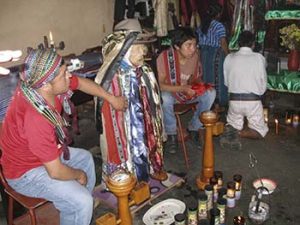 Entering the room we found the shaman sporting a colourful scarf on his head. Set on top of an altar, next to the shaman, was Rilaj Mam decked out in colourful silk scarves and a gray Stetson. The scarves are changed regularly and each one is said to represent a miracle that he has performed.
Entering the room we found the shaman sporting a colourful scarf on his head. Set on top of an altar, next to the shaman, was Rilaj Mam decked out in colourful silk scarves and a gray Stetson. The scarves are changed regularly and each one is said to represent a miracle that he has performed.
Suddenly the shaman took a mouth full of rum from one of the nearby bottles and sprayed it all over a statue. He then followed that up with a lighted cigar which he carefully inserted into the statue’s mouth. The shaman repeated this offering roughly every 10-15 minutes. For some strange reason the thought of an alcoholic statue with lung cancer flashed through my mind.
Alex outlined the evolution of the Mayan saint named Rilaj Mam. The Creole population knows him as Maximón (pronounced Maa-shee-mohn) and he is San Simon to the local Catholics. The Roman Catholic Church does not approve of the worship of Maximón. The shaman circumvents this by including a second altar with statues of the Virgin Mary flanked by two saints on top. Nearby was a well-dressed Jesus nailed to a 6-foot tall crucifix that was leaning against the wall. I did not see the shaman offer Jesus any rum or cigars.
After saying goodbye to the shaman, our tuk-tuk carried us outside of town and to the summit of a mirador (viewpoint) overlooking Santiago de Atitlán. We had a spectacular view of the San Pedro volcano in the distance which rises to a height of 3020 meters. After admiring the view of that mountain, we looked below us to find a number of Mayan women doing their laundry in the lake as they have done at this site for centuries.
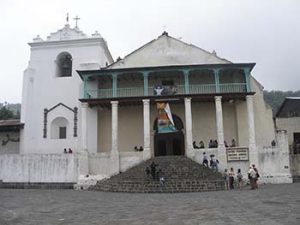 After a hair-raising tuk-tuk ride back into town, our driver left us at the square in front of the Church of St. James the Apostle, built between 1572 and 1581, with its dingy yellow exterior. The present structure was not the first church to occupy this site. The first was built by the Spanish in 1541.
After a hair-raising tuk-tuk ride back into town, our driver left us at the square in front of the Church of St. James the Apostle, built between 1572 and 1581, with its dingy yellow exterior. The present structure was not the first church to occupy this site. The first was built by the Spanish in 1541.
The Mayans who actually built this church might have secretly commemorated the temple that once stood on this site when they included a flight of 20 steps leading to the front door of the church. A single month of the Mayan calendar consists of 20 days.
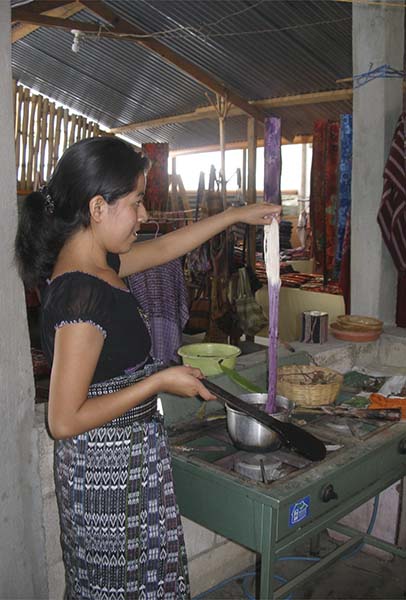 Entering the church, the yellow walls running the length of the building are lined with wooden statues of various saints. Each saint sports unique garments produced by the local women. Looking toward the apse you find three altarpieces representing the local volcanoes. Alex conspicuously pointed out a carving of Maximón at the base of one of the columns supporting the roof.
Entering the church, the yellow walls running the length of the building are lined with wooden statues of various saints. Each saint sports unique garments produced by the local women. Looking toward the apse you find three altarpieces representing the local volcanoes. Alex conspicuously pointed out a carving of Maximón at the base of one of the columns supporting the roof.
Exiting the church, we returned to the speedboat for our next destination – the sleepy little village of San Juan La Laguna which is known for the colourful textiles produced by the local women’s cooperative. The members of the cooperative produce hand woven cloth using the traditional Mayan waist loom and natural dyes from the local plants. Inside the cooperative, don’t be surprised to find one of the women seated on the floor with a strap around her waist in order to hold a loom suspended between her and a nearby post. [TOP PHOTO] You will notice that she constantly repositions herself so as to maintain the tension in the warp and weft as she weaves.
San Juan La Laguna is also known for a number of local painters. You will not only discover art galleries filled with paintings capturing the local scenery but you may also find murals on some of the buildings are you wander through the narrow streets.
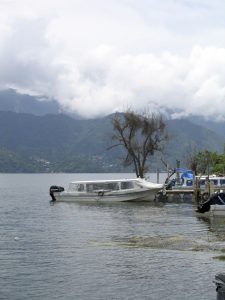
Your final destination by speedboat is the quiet little town of San Pedro La Laguna, set at the base of the volcano of the same name. Upon our arrival we jumped out of the boat and went directly to the Café Cristalinas. Once inside, the staff told us about the different Guatemalan coffee growing regions and the differences in taste. We sampled some freshly roasted Arabica coffee and cocoa beans, both of which are grown on the nearby slope in the rich volcanic soil. Combine these taste sensations with the panoramic view of the lake from the open-air cafe and there is nowhere else that we would rather have been at the time. But paradise is sometimes fleeting and we had to return to Panajachel, but not before we purchased a pound of dark roast coffee. We had just enough time to put the coffee into our backpack and jump into the boat before it left.
The water was noticeably choppier than it was this morning as our boat skipped over the waves en route to Panajachel. Upon arrival at the dock you will likely have a few minutes to visit some of the stalls lining Calle Real in search of that perfect souvenir if you weren’t able to do so at any of the previous towns. Unfortunately we had to tear ourselves away from the laidback Panajachel lakefront and return to Antigua but not before thinking that Lake Atitlan would be a relaxing retirement destination someday.
If You Go:
You can arrange a tour to Lake Atitlán as a daytrip from Antigua. Reservations can usually be made at your hotel. The boat ride to each town is included in the tour.
A tuk-tuk ride costs 20 Quetsals.
Admission to visit Maximón is 2 Quetsals. You can take his picture for 10 Quetsals. It is not possible to provide an address for where Maximón is located because this changes every year.
Admission to the Church of St. James the Apostle (Iglesia Parochial Santiago Apostol) is free.
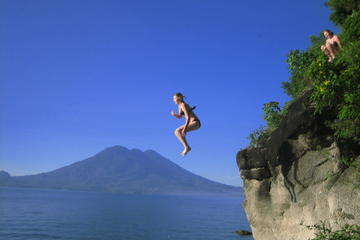
Lake Atitlan Off The Beaten Path: A Day Full of Adventure from Antigua
About the author:
Troy Herrick, a freelance travel writer, has traveled extensively in North America, the Caribbean, Europe and parts of South America. His articles have appeared in Live Life Travel, International Living, Offbeat Travel and Travels Thru History Magazines.
Photo credits:
Diane Gagnon, a freelance photographer, has traveled extensively in North America, the Caribbean, Europe and parts of South America. Her photographs have accompanied Troy Herrick’s articles in Live Life Travel, Offbeat Travel and Travels Thru History Magazine



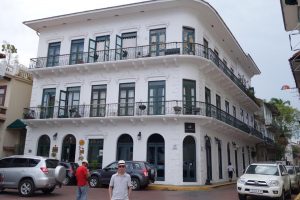
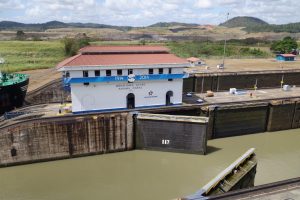
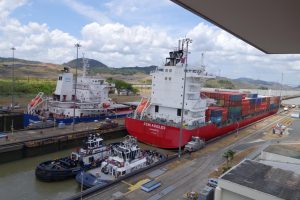
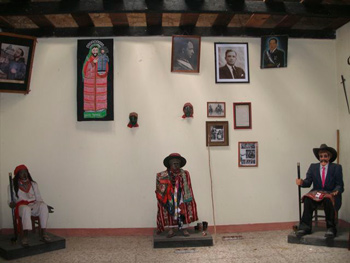
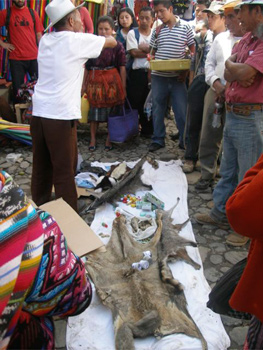 Stepping out of the bus at Chichicastenango on market day is like being hit right between the eyes. You are met by a loud seemingly chaotic atmosphere filled with unintelligible languages, the smell of burning incense and traditional herbs and a sea of bright colored clothing. The maze of temporary stalls through which you must pass in order to reach the tourist sites adds to your sensory overload.
Stepping out of the bus at Chichicastenango on market day is like being hit right between the eyes. You are met by a loud seemingly chaotic atmosphere filled with unintelligible languages, the smell of burning incense and traditional herbs and a sea of bright colored clothing. The maze of temporary stalls through which you must pass in order to reach the tourist sites adds to your sensory overload. Take your time looking around for the best deal because prices are cheaper further away from the center of town and you are heading toward the centre of town.
Take your time looking around for the best deal because prices are cheaper further away from the center of town and you are heading toward the centre of town.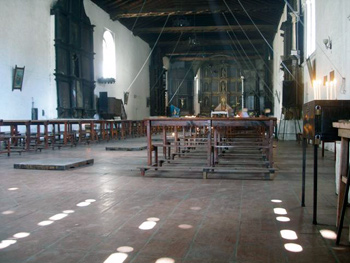 The dimly lit interior of the church is saturated with smoke from past Mayan offerings. Take care where you step because you might accidentally walk over the remnants of an offering of flowers, corn or even alcohol set on or near one of ten low concrete platforms running along the length of the center aisle. Multi-colored gobs of wax suggest that the candles were set in pre-arranged patterns on these once-smooth surfaced altars. Roughly finished planks cover the apse behind the “Catholic” altar. Three saintly statues are set on recesses in each of the side walls. After observing the mix of two religions I could almost imagine these statues saying to themselves of their Mayan co-tenants “If you can’t beat them, join them.”
The dimly lit interior of the church is saturated with smoke from past Mayan offerings. Take care where you step because you might accidentally walk over the remnants of an offering of flowers, corn or even alcohol set on or near one of ten low concrete platforms running along the length of the center aisle. Multi-colored gobs of wax suggest that the candles were set in pre-arranged patterns on these once-smooth surfaced altars. Roughly finished planks cover the apse behind the “Catholic” altar. Three saintly statues are set on recesses in each of the side walls. After observing the mix of two religions I could almost imagine these statues saying to themselves of their Mayan co-tenants “If you can’t beat them, join them.”
 You can also cross the plaza and visit the Calvary Chapel which is a scaled-down version of the Church of Saint Thomas. Inside there are only three low concrete slabs on which to place offerings. The apse features an intricately carved wooden altar and the side walls feature hand-painted murals.
You can also cross the plaza and visit the Calvary Chapel which is a scaled-down version of the Church of Saint Thomas. Inside there are only three low concrete slabs on which to place offerings. The apse features an intricately carved wooden altar and the side walls feature hand-painted murals.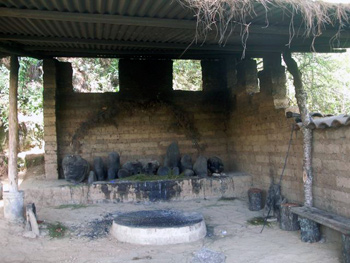 The owner of the museum proudly pointed out that both he and his forbearers were all shamans. After touring the museum, the owner invited us to visit the Mayan altar set on the hillside behind the museum. After a short, steep climb we arrived at a large stone approximately 6 by 12 square feet and 18 inches high set under an awning. Fourteen small stones and two crosses placed there by the Spanish were the only decorative features. At the center of the altar is a shallow depression approximately 4.5 feet in diameter that is still used for burnt offerings by Mayan Shamans. Some straw fibers were still visible on the altar surface, likely from a recent offering.
The owner of the museum proudly pointed out that both he and his forbearers were all shamans. After touring the museum, the owner invited us to visit the Mayan altar set on the hillside behind the museum. After a short, steep climb we arrived at a large stone approximately 6 by 12 square feet and 18 inches high set under an awning. Fourteen small stones and two crosses placed there by the Spanish were the only decorative features. At the center of the altar is a shallow depression approximately 4.5 feet in diameter that is still used for burnt offerings by Mayan Shamans. Some straw fibers were still visible on the altar surface, likely from a recent offering.
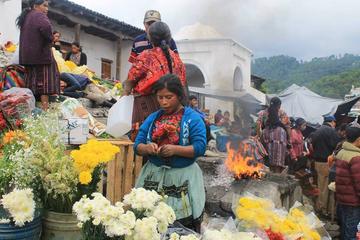

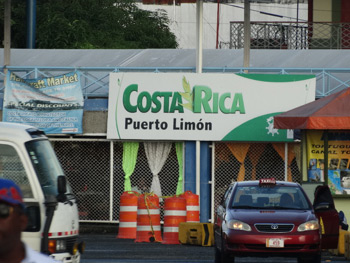
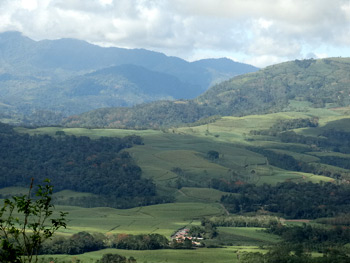 The view and scenery from here are spectacular. Set against the bright blue sky, the Turralba Volcano sends out puffs of white and gray smoke into the clouds. A thick carpet of trees covers the surrounding mountainsides.
The view and scenery from here are spectacular. Set against the bright blue sky, the Turralba Volcano sends out puffs of white and gray smoke into the clouds. A thick carpet of trees covers the surrounding mountainsides.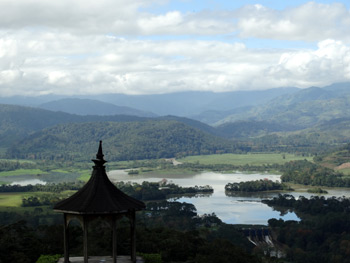 In the hacienda’s grounds, we hear numerous varieties of birds singing softly in the trees. Green, violet and translucent blue-winged hummingbirds buzz and zoom around our heads in colorful blurs. They eagerly seek the nectar of the yellow, white and fuchsia flowers bunched around us.
In the hacienda’s grounds, we hear numerous varieties of birds singing softly in the trees. Green, violet and translucent blue-winged hummingbirds buzz and zoom around our heads in colorful blurs. They eagerly seek the nectar of the yellow, white and fuchsia flowers bunched around us.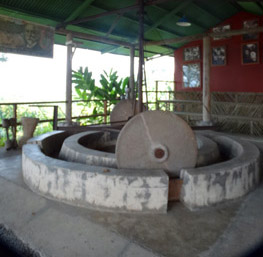 The red coffee berries are peeled and poured into a large concrete circular mill. Two men continuously push a heavy wooden arm around the mill crushing the beans against the concrete walls. We hear a loud grinding and crunching sound.
The red coffee berries are peeled and poured into a large concrete circular mill. Two men continuously push a heavy wooden arm around the mill crushing the beans against the concrete walls. We hear a loud grinding and crunching sound.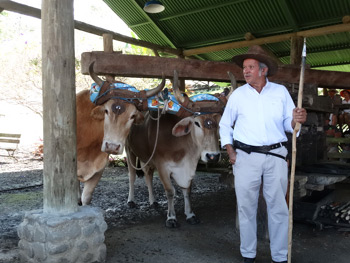 The plantation grows several acres of sugarcane. Brown sugar is extracted by placing the sugar cane stems through a wooden press. Two huge white oxen, walking around a circular dirt path, turn the press’s immense wooden wheel. The pressure makes the can juice ooze out from the crushed stems, into a bucket. The juice is then cooked in a hot oven. Three workers then pour the juice into a mold.
The plantation grows several acres of sugarcane. Brown sugar is extracted by placing the sugar cane stems through a wooden press. Two huge white oxen, walking around a circular dirt path, turn the press’s immense wooden wheel. The pressure makes the can juice ooze out from the crushed stems, into a bucket. The juice is then cooked in a hot oven. Three workers then pour the juice into a mold.
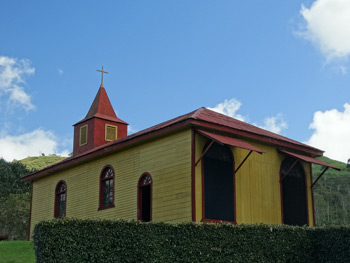 After lunch we walk up a short grassy slope, to the chapel. The Ortuno family chapel, built in 1880, has stained glass windows. The sun reflects brilliantly through them, illuminating the room with warm reds, blues, yellows and golds. Art adorns the walls. Statues depicting Christian figures came from Germany.
After lunch we walk up a short grassy slope, to the chapel. The Ortuno family chapel, built in 1880, has stained glass windows. The sun reflects brilliantly through them, illuminating the room with warm reds, blues, yellows and golds. Art adorns the walls. Statues depicting Christian figures came from Germany.
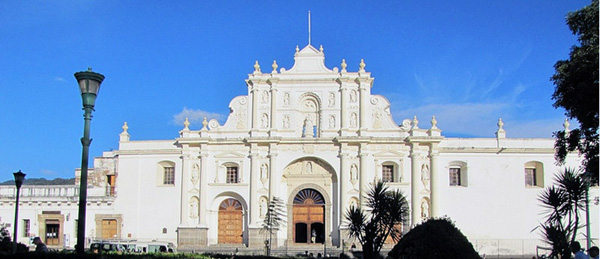
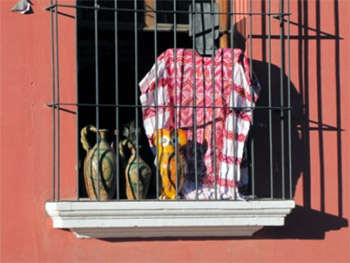 Nowadays, Antigua is a UNESCO World Heritage Site. What the mass exodus of 1773 left behind were around forty once-sturdy stone churches, beautiful cobblestone streets, and a vibrant culture not swallowed by the dirt and danger of today’s capital. Antigua’s streets are lined with pastel storefronts. Its parks are highly trafficked with pedestrians and thick with greenery. Its population is a fantastic mix of indigenous Maya, locals, international volunteers, long-time expats, and travelers who just can’t bring themselves to leave.
Nowadays, Antigua is a UNESCO World Heritage Site. What the mass exodus of 1773 left behind were around forty once-sturdy stone churches, beautiful cobblestone streets, and a vibrant culture not swallowed by the dirt and danger of today’s capital. Antigua’s streets are lined with pastel storefronts. Its parks are highly trafficked with pedestrians and thick with greenery. Its population is a fantastic mix of indigenous Maya, locals, international volunteers, long-time expats, and travelers who just can’t bring themselves to leave.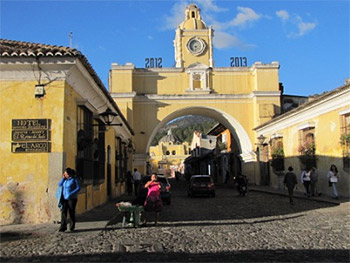 From Parque Central, its shade trees and centerpiece Mermaids’ Fountain, things spread in all directions. The ruins, churches, markets, and restaurant-café-bars are too plentiful to take in in one day of exploration, but rather it’s best to choose a healthy mix of sites. For me, there are certain highlights I like to use to create the initial wow for visiting relatives:
From Parque Central, its shade trees and centerpiece Mermaids’ Fountain, things spread in all directions. The ruins, churches, markets, and restaurant-café-bars are too plentiful to take in in one day of exploration, but rather it’s best to choose a healthy mix of sites. For me, there are certain highlights I like to use to create the initial wow for visiting relatives: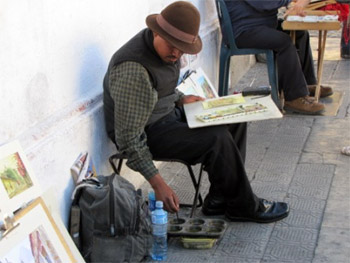 ♦ Ruins: Like churches, ruins sightings occur here on a block-by-block basis. For the most remarkably sprawling specimen, La Recolección Architectural Complex, head to the far west edge of town, beyond the market and “bus station” (a parking lot with a collection of remodeled US school buses, aka chicken buses, which are a sight in and of themselves). La Recolección is a former monastery now surround by parkland.
♦ Ruins: Like churches, ruins sightings occur here on a block-by-block basis. For the most remarkably sprawling specimen, La Recolección Architectural Complex, head to the far west edge of town, beyond the market and “bus station” (a parking lot with a collection of remodeled US school buses, aka chicken buses, which are a sight in and of themselves). La Recolección is a former monastery now surround by parkland.